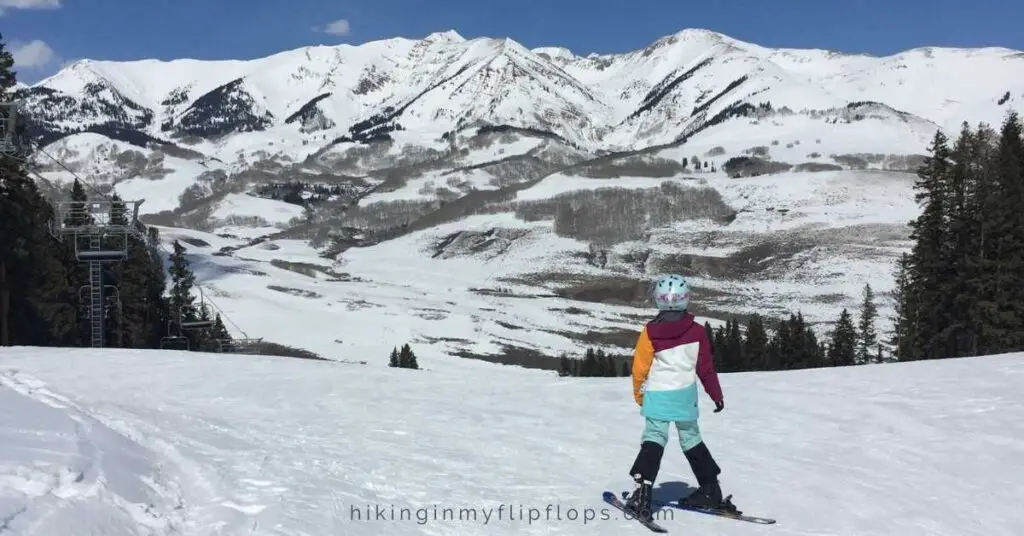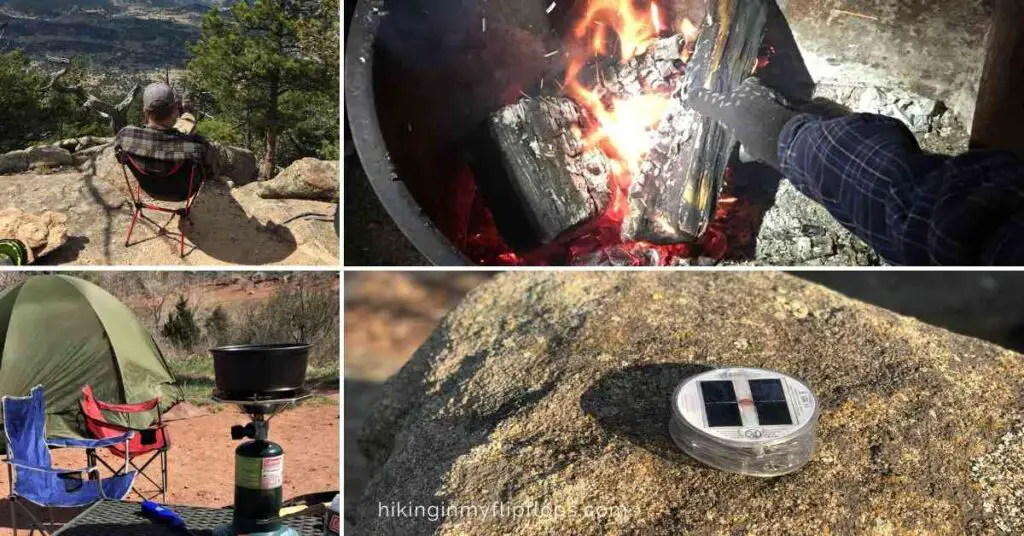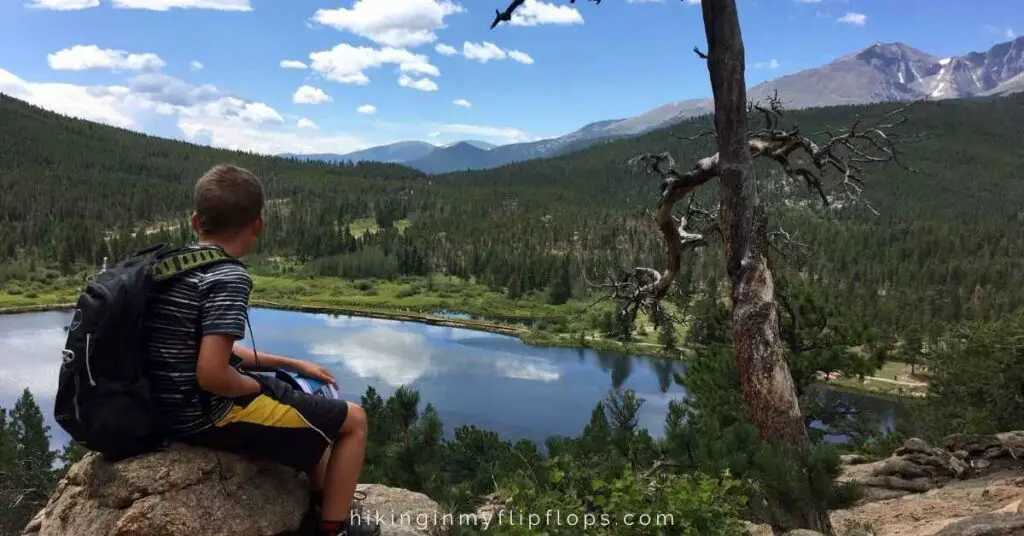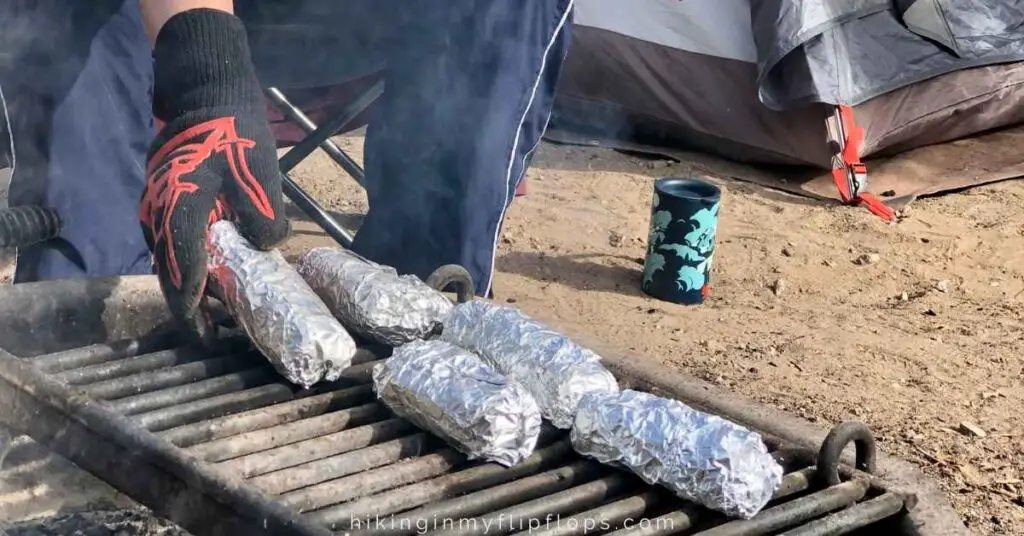The tent is the biggest and perhaps most complicated purchase of all the gear needed for a family camping trip. Tents come in a wide range of sizes, shapes, colors, materials, and more features than you can begin to imagine. Buying a tent for camping quickly gets overwhelming.
So how to choose a family tent for your next camping trip? Our tent buying guide breaks it down into 3 simple steps to quickly get you out on your next camping adventure.
(This post may contain affiliate links. Please read our disclosure policy for more information.)
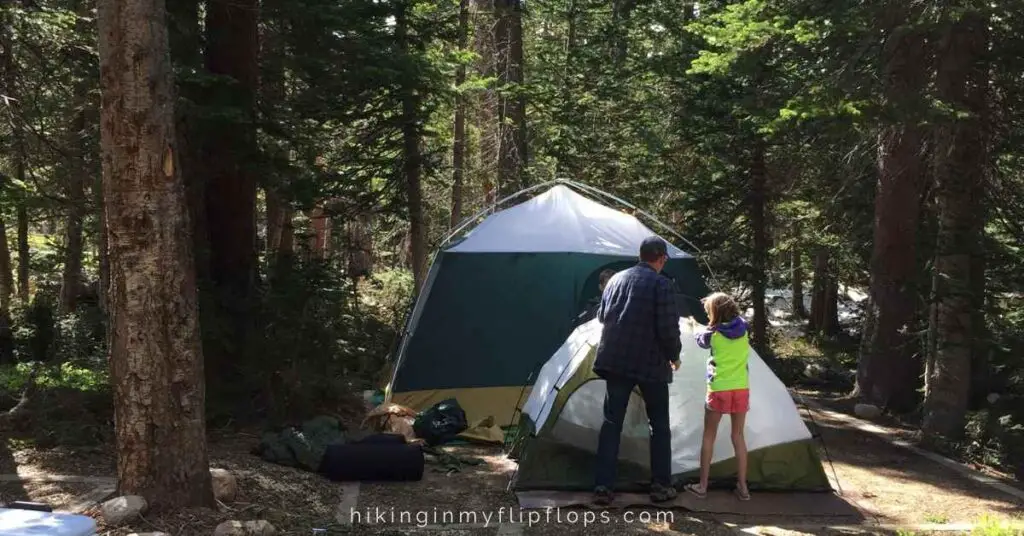
The Family Tent Buying Guide: 3 Simple Steps
Whether you are new to camping or an experienced camper, these tips can help you narrow down the perfect tent for your family.
Determine the Right Tent Size
The first step in choosing a tent is to narrow it down to the right-sized tent, which means both the square footage and the height.
Tent sleeping capacity is simply based on how many sleeping bags can fit in the tent. It does not mean the number of people the tent will hold comfortably. Also, consider how you want to sleep. Families camping with teens may consider 2 smaller tents rather than one large tent.

Tip: As a rule of thumb, subtract 2 from the sleeping capacity to get to that “comfort” sizing. Six-person tents will sleep 4 comfortably (with gear). If you want extra space for items like side tables, organizers, or other equipment, go with an even larger tent.
There is no industry standard for sleeping capacity. The Alps Mountaineering Taurus 6-Person Tent has about 30 sq ft more floor space than Kelty’s 6-Person Wireless Tent. Most manufacturers provide the square footage of the tent floor. Compare people capacity and square footage across your final tent choices.
Tip: Maximize floor space by using cots over air mattresses or pads. Use the space underneath the cot for gear storage.
How to Choose a Family Tent Height
Height is also a factor and depends on preference. Look for a peak height that is tall enough to stand in, or be prepared to crawl or stoop throughout the tent.

The shape of the tent determines how much of that height is usable. Cabin and tunnel tents have more standing room than dome and A-frame tents.
- Cabin and tunnel tents have the most flexibility in standing space with little to no sloping in the tent.
- The peak height in A-frame, geodesic, dome, and teepee tents may allow only a small area that is tall enough to stand in.
You May Also Like: 14 Types of Tents for Camping: A Simplified Guide to Styles and Best Uses
Tip: Cots and other bedding with height can have limited placement in tents with sloped walls, like a dome or A-frame.
Choosing the Right Tent Within Your Budget
If you’re trying to keep the cost of your camping trip down, focus on good basic tents. Tent prices can range from well under $100 to several hundred dollars. Size, brand, pole construction, tent weight, and material all factor into the price of a camping tent.
There is typically a tent for every budget, so the next step is to focus on the tent features that are most important to you.
Tip: If you’re new to camping, go for lower-priced tents (this doesn’t have to mean low-quality cheap tents). You’ll learn what matters to you in a tent and will be more confident in your purchase when ready to upgrade.
Choose the Most Important Tent Features
All the different features of camping tents make choosing the right tent overwhelming. Below is a list of the most common features people consider when choosing a tent. Quickly narrow down the possibilities by selecting the most essential features for your family.
Number of Doors & Windows
Most tents have 1 or 2 doors, but some tents have more.
A tent with 2 (or more) doors has some benefits:
- you can avoid worrying about which way the tent is facing when you set it up
- they separate exit/entryways for restroom breaks in the middle of the night
The number of windows (and size of windows) can vary greatly. Some have stargazing ceilings, while others have no windows at all. The no-see-um mesh in windows allows for cross breezes and stargazing. But there is less insulation in colder weather and less privacy.
Pole Construction
Tent poles are constructed for the material and type of tent, so you probably wouldn’t choose a tent by the pole material. Still, it’s good to understand the different types.
- Fiberglass poles are lightweight and are the most affordable option, but they can splinter easily.
- Aluminum poles are also lightweight but are less prone to damage, making them good options for windy conditions. But, these poles can pose a safety risk in a thunderstorm and will rust over time.
- Tent poles made from steel are the most durable but are also the heaviest. Exceptionally large tents, or those made with hefty material (like canvas), use steel poles.
Ease of Zipper
A tent with a one-handed zipper operation is a great feature when your hands are full with the little ones.
Ease of Setup
A standard setup tent can take time and at least two people to pitch, but there are options for quick setup or if you’re working solo.
- Instant tents have pre-attached poles that simply need to be connected to pitch the tent.
- A pop-up tent is folded and secured into a bag, making them a breeze to set up.
Core tents are popular for their easy, instant setup.
Tip: Focus your search on instant tents when there is only one person to set up the tent.
Vestibule
A vestibule is an added area, usually in front of the tent. This space is covered on the top and sides but not on the bottom. These are also called a gear garage, screen room, or front porch. An excellent spot to store your gear (but not food!) out of the elements but out of the sleeping area. Also great for escaping light rain without being fully inside the tent.
They vary in size, so verify the dimensions if this feature is essential. The vestibule in our Kelty Trail Ridge is only large enough for shoes, while our Wawona 6 from The North Face has plenty of space for 2-3 camp chairs.
Keep in mind: Large vestibules can add more weight and bulk to the tent, but they protect during rainy weather or intense sun. These are a great alternative to packing a separate canopy.
Gear Pockets
Integrated pockets for storing phones, glasses, headlamps, and other valuables that easily get lost in a tent (or are hard to find in the dark). They are generally small (at best, these may fit a pair of flip-flops) but great for organizing small items.
Number of Rooms
Larger families may want extra privacy offered with separate rooms within the tent. Rooms are often created by hanging room dividers included with the tent and are a common feature in large camping tents.
Warranty
A very excited puppy once tried to claw her way through the mesh of our Kelty. We contacted Kelty for recommendations on how to best fix the hole, and they offered to do the repair at no cost to us.
Tents tear, zippers break, and poles snap. A good warranty (or a company that stands behind their product) may be necessary, especially with more expensive tents.
Weight
This feature is significant if you will be carrying the tent for any distance. Tent size, material, and pole construction factor into the tent’s weight.
Pay attention to the weight if you’ll ever consider backcountry camping with your tent.
Waterproofness
It’s Murphy’s Law – no matter the forecast, it seems to always rain when you are camping. If you camp in areas where this happens often, look for tents with high waterproofness: the tent’s ability to stay dry. Tent manufacturers give a lot of technical specs on waterproofness but little explanation.
All tents will keep you dry in light rain. However, there are marked differences between the tents’ ability to stay dry in long or heavy rain. If you plan to stick it out in heavy downpours, consider a tent rated “best” for waterproofness. Marmot’s Limestone is a highly rated tent with a high waterproof rating.
Season Rating
- Two- and three-season tents are the most common for car campers. They allow for flexibility in a range of temperatures and inclement weather.
When to look at a 1- or 4-season tent: if you plan to camp exclusively in certain climates.
- One-season tents are best for warm, dry weather when you want to keep cool while camping. They are breathable, but they are not very insulating or waterproof.
- On the other hand, a four-season tent is very insulating and weatherproof. It can keep you warm and cozy through the night at the campground but can be stuffy in warm temps.
The Best Places for Buying a Tent for Camping
Where to buy family camping tents is almost as important as knowing how to choose a family tent. Whether you buy directly from the manufacturer or from another retailer, there are plenty of buying options for the best camping tent brands.
- REI carries top camping tent brands such as Kelty, Eureka, and Marmot, in addition to REI-branded tents.
- Cabela’s also has its own line of tents and a great selection of heavy-duty canvas tents.
- Find Coleman, Kelty, Eureka, and Field & Stream branded tents at Dick’s Sporting Goods.
- Target has store-branded tents (Embark) and a selection from brands like Core and Klymit.
- Walmart sells a variety of camping tent brands, including its own line of tents (Ozark Trail)
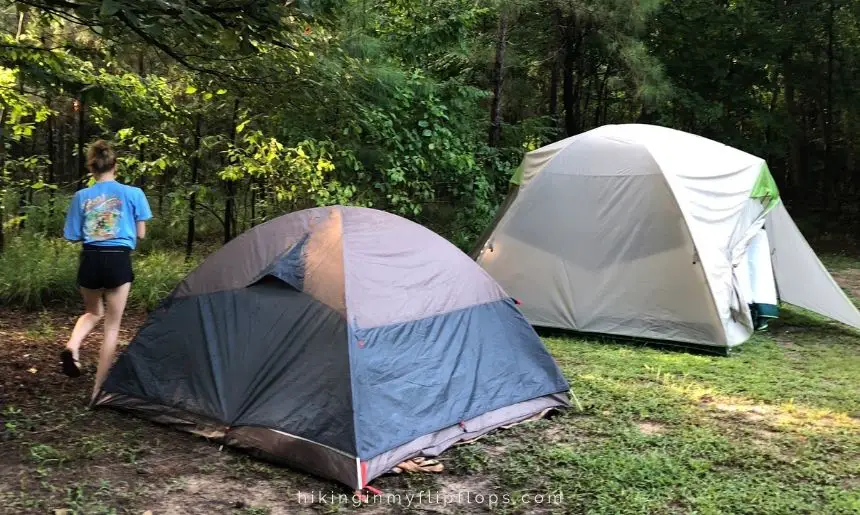
Tent Terminology Explained
Manufacturers and retailers may describe or refer to other standard tent features. Understanding what these mean can help make your tent selection easier, so you know how to choose a tent for your family.
Footprint
A footprint is a custom-fit protective layer between the tent and the ground.
Footprints can be purchased separately if a tent does not come with one. If it’s not included, any tarp underneath the tent works just as well and is a cheaper alternative to a footprint.
Rain fly (or fly for short)
A separate layer over the tent protects from the elements, specifically the rain. The fly is more waterproof than the tent material itself to keep the tent dry inside.
Ground cover
Sometimes called the ground cloth, this is a layer (usually just a tarp) between the tent and the ground. This extra layer protects the floor of the tent from damage or water.
It’s not a custom fit like a footprint, but any tarp as big (or bigger) than the tent itself will work.
Guy lines
The ropes or strings are used to secure the tent to the ground. The lines are attached to the tent and held in place with tent stakes.
Tub floor
The tent’s floor is the most durable part (footprints or ground covers are still recommended), but water can seep into a tent at the seams where the walls meet the floor. Tents with tub floors have these seams a few inches off the floor (creating a tub shape), reducing the risk of leaks in heavy rains.
No-see-em Mesh
Tent windows are made from breathable mesh enough for breezes and rain to come through but prevent the tiniest bugs from getting into the tent.
Gear loft
Storage space at the top of the tent. A mesh or other lightweight material ties to the top of the tent for organizing lightweight gear.
Tent Stakes
Tents are secured by pinning the guy lines to the ground with stakes. Car camping tent stakes are generally steel, while lighter-weight aluminum stakes are found with backpacking tents.
Freestanding Tent
Some tents are set up by securing them to the ground with tent stakes, then standing up with the tent poles. Freestanding tents don’t require stakes for setup, allowing for repositioning or moving the tent without taking it down.
Tents that are not freestanding are less common and are used more often by backpackers to reduce the tent weight. This one from River Country uses trekking poles (not included with the tent) to keep it upright, so the only additional gear needed are stakes to secure it in place.
Single-Wall and Double-Wall
Most family tents are double-wall, meaning they have a separate rain fly for the waterproof layer. The thinner walls in this type of tent are more breathable and give some flexibility in warmer weather.
The tent body of single-wall tents provides protection from the elements without additional weight. These are primarily used in backpacking and mountaineering tents. This type of material tends to create condensation in the tent, especially in colder weather.
There are so many family tent options out there, choosing the right tent for your family can be overwhelming. Knowing how to pick the right tent by size, budget, and features can make the hunt for the perfect tent a fun experience.
Click below to save this tent buying guide on Pinterest!












